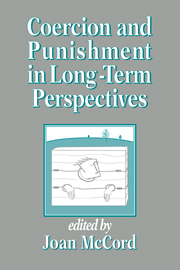Book contents
- Frontmatter
- Contents
- List of contributors
- Acknowledgments
- 1 Introduction: coercion and punishment in the fabric of social relations
- I Mental health, coercion, and punishment
- II Family socialization practices and antisocial behavior
- 5 Coercion as a basis for early age of onset for arrest
- 6 Disentangling mother–child effects in the development of antisocial behavior
- 7 Family and child factors in stability and change in children's aggressiveness in elementary school
- 8 Kindergarten behavioral patterns, parental practices, and early adolescent antisocial behavior
- 9 The reciprocal influence of punishment and child behavior disorder
- 10 The development of coercive family processes: the interaction between aversive toddler behavior and parenting factors
- III Aggression and coercion in the schools
- IV Deviance, crime, and discipline
- V Measuring and predicting in studies of coercion and punishment
- Name index
- Subject index
10 - The development of coercive family processes: the interaction between aversive toddler behavior and parenting factors
Published online by Cambridge University Press: 29 September 2009
- Frontmatter
- Contents
- List of contributors
- Acknowledgments
- 1 Introduction: coercion and punishment in the fabric of social relations
- I Mental health, coercion, and punishment
- II Family socialization practices and antisocial behavior
- 5 Coercion as a basis for early age of onset for arrest
- 6 Disentangling mother–child effects in the development of antisocial behavior
- 7 Family and child factors in stability and change in children's aggressiveness in elementary school
- 8 Kindergarten behavioral patterns, parental practices, and early adolescent antisocial behavior
- 9 The reciprocal influence of punishment and child behavior disorder
- 10 The development of coercive family processes: the interaction between aversive toddler behavior and parenting factors
- III Aggression and coercion in the schools
- IV Deviance, crime, and discipline
- V Measuring and predicting in studies of coercion and punishment
- Name index
- Subject index
Summary
Introduction
The purpose of the study reported here was to identify developmental precursors of coercive parent–child interaction and child externalizing behavior by examining child and parental behavior, and the interaction of the two during a period critical to the child's socialization process, ages 1 to 2. Although much research has been conducted on the maintenance of coercive family processes and its relation to child externalizing behavior, few investigators have examined the precursors of coercive processes in the early parent–child relationship. Several consistent findings in the development of externalizing behavior in children have served to highlight the importance of the early parent–child relationship. First, aggressive and disruptive behavior are already stable behavioral patterns in school-age children, especially for boys (Cummings, Iannotti, & Zahn-Waxier, 1989; Huessman, Eron, Lefkowitz, & Walder, 1984; Olweus, 1979). Second, family management practices are related to the development of both prosocial and antisocial behavior in children (Block, Block, & Morrison, 1981; Londerville & Main, 1981; Loeber & Stouthamer-Loeber, 1986; Martin, 1981; McCord, 1979; Patterson, 1982; Patterson, Capaldi, & Bank, 1991). Therefore, factors involved in the initiation of coercive family processes and child externalizing behavior may be first evident in the toddler period, when parents and children begin to engage in struggles for the first time.
Although little is known about the stability of aggression in preschool children, among school-age children and adolescents stability of aggression has been well established.
- Type
- Chapter
- Information
- Coercion and Punishment in Long-Term Perspectives , pp. 165 - 180Publisher: Cambridge University PressPrint publication year: 1995
- 23
- Cited by

